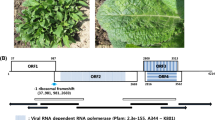Abstract
A novel umbra-like virus was identified in arborvitae in South Korea using RNA sequencing (RNA-seq). The virus identified was tentatively named "arborvitae umbra-like virus" (AULV) and contained a 4,300-nucleotide genome organized into four non-structural open reading frames (ORFs). Cloning and Sanger sequencing were used to confirm the viral contig sequence and determine the size of the genome. Genome analysis indicated that ORF2 encodes an RNA-dependent RNA polymerase that is probably expressed through ribosomal frameshifting. ORF3 encodes a putative long-distance movement protein, while the functions of ORFs 1 and 4 are unknown. The virus lacks a coat protein gene. The genome of AULV shares 27.3%–48.4% nucleotide sequence identity with closely related umbraviruses. Phylogenetic analysis based on the complete genome sequences and amino acid sequences of the RNA-dependent RNA polymerase revealed that AULV forms a monophyletic lineage with Guiyang paspalum paspaloides tombus-like virus (GPpTV1). We suggest that AULV is a novel umbra-like virus belonging to the family Tombusviridae.


Similar content being viewed by others
Data availability
All data generated or analysed during this study are included in this published article [and its supplementary information files].
References
Tahir MN, Bolus S, Grinstead SC, McFarlane SA, Mollov D (2021) A new virus of the family Tombusviridae infecting sugarcane. Adv Virol 166(3):961–965
Tang J, Lebas B, Liefting L, Veerakone S, Wei T, Ward L (2016) Opium poppy mosaic virus, a new umbravirus isolated from Papaver somniferum in New Zealand. Adv Virol 161(1):197–201
Taliansky ME, Robinson DJ (2003) Molecular biology of umbraviruses: phantom warriors. J Gen Virol 84(8):1951–1960
Canetta E, Kim SH, Kalinina NO, Shaw J, Adya AK, Gillespie T, Brown JWS, Taliansky M (2008) A plant virus movement protein forms ringlike complexes with the major nucleolar protein, fibrillarin, in vitro. J Mol Biol 376(4):932–937
Yoo RH, Lee SW, Lim S, Zhao F, Igori D, Baek D, Hong JS, Lee SH, Moon JS (2017) Complete genome analysis of a novel umbravirus-polerovirus combination isolated from Ixeridium dentatum. Adv Virol 162(12):3893–3897
Lim S, Lee SH, Moon JS (2019) Complete genome sequence of a tentative new umbravirus isolated from Patrinia scabiosaefolia. Adv Virol 164(9):2375–2378
Syller J (2003) Molecular and biological features of umbraviruses, the unusual plant viruses lacking genetic information for a capsid protein. Physiol Mol Plant Pathol 63(1):35–46
Liu J, Simon AE (2022) Identification of novel 5′ and 3′ translation enhancers in umbravirus-like coat protein-deficient RNA replicons. J Virol 96(7):e01736-21
Liu J, Carino E, Bera S, Gao F, May JP, Simon AE (2021) Structural analysis and whole genome mapping of a new type of plant virus subviral RNA: umbravirus-like associated RNAs. Viruses 13(4):646
Sang HK, MacFarlane S, Kalinina NO, Rakitina DV, Ryabov EV, Gillespie T, Haupt S, Brown JWS, Taliansky M (2007) Interaction of a plant virus-encoded protein with the major nucleolar protein fibrillarin is required for systemic virus infection. Proc Natl Acad Sci USA 104(26):11115–11120
Antunes TFS, Amaral RJV, Ventura JA, Godinho MT, Amaral JG, Souza FO, Zerbini PA, Zerbini FM, Fernandes PMB (2016) The dsRNA virus papaya meleira virus and an ssRNA virus are associated with papaya sticky disease. PLoS ONE 11(5):1–14
Koloniuk I, Přibylová J, Čmejla R, Valentová L, Fránová J (2022) Identification and characterization of a novel umbra-like virus, strawberry virus a, infecting strawberry plants. Plants 11(5):643
Wang X, Olmedo-Velarde A, Larrea-Sarmiento A, Simon AE, Kong A, Borth W, Suzuki JY, Wall MM, Hu J, Melzer M (2021) Genome characterization of fig umbra-like virus. Virus Genes 57(6):566–570
Kshirsagar S, Malode S, Bansode S (2018) PHARMCOLOGICAL ACTIVITY OF THUJA ORIENTALIS LINN. Int J Pharmacognosy 5(6):331–336
Belete MT, Gudeta WF, Kim SE, Igori D, Moon JS (2021) Complete genome sequence of Codonopsis torradovirus A, a novel torradovirus infecting Codonopsis lanceolata in South Korea. Adv Virol 0123456789:1–4
Zheng L, Fu S, Xie Y, Han Y, Zhou X, Wu J (2022) Discovery and characterization of a novel umbravirus from Paederia scandens plants showing leaf chlorosis and yellowing symptoms. Viruses 14(8):1821
Quito-Avila DF, Reyes-Proaño EG, Mendoza A, Margaria P, Menzel W, Bera S, Simon AE (2022) Two new umbravirus-like associated RNAs (ulaRNAs) discovered in maize and johnsongrass from Ecuador. Adv Virol 167(10):2093–2098
Acknowledgments
This work was supported by IPET (Korea Institute of Planning and Evaluation for Technology in Food, Agriculture, Forestry and Fisheries; Project No. AGC1762111), Ministry of Agriculture, Food and Rural Affairs, Republic of Korea. We thank Mike Herbert, PhD, from Edanz (www.edanz.com/ac) for editing a draft of this manuscript.
Funding
Korea Institute of Planning and Evaluation for Technology in Food, Agriculture, Forestry and Fisheries (Project No. AGC1762111).
Author information
Authors and Affiliations
Corresponding authors
Ethics declarations
Conflict of interest
All authors declare no conflict of interest.
Ethical approval
This article does not contain any studies with animals or human participants performed by any of the authors.
Additional information
Handling Editor: Massimo Turina.
Publisher's Note
Springer Nature remains neutral with regard to jurisdictional claims in published maps and institutional affiliations.
Supplementary Information
Below is the link to the electronic supplementary material.
Rights and permissions
Springer Nature or its licensor (e.g. a society or other partner) holds exclusive rights to this article under a publishing agreement with the author(s) or other rightsholder(s); author self-archiving of the accepted manuscript version of this article is solely governed by the terms of such publishing agreement and applicable law.
About this article
Cite this article
Belete, M.T., Kim, S.E., Kwon, JA. et al. Molecular characterization of a novel umbra-like virus from Thuja orientalis (arborvitae) in South Korea. Arch Virol 168, 197 (2023). https://doi.org/10.1007/s00705-023-05783-w
Received:
Accepted:
Published:
DOI: https://doi.org/10.1007/s00705-023-05783-w




